display Citroen C4 PICASSO 2016 2.G Service Manual
[x] Cancel search | Manufacturer: CITROEN, Model Year: 2016, Model line: C4 PICASSO, Model: Citroen C4 PICASSO 2016 2.GPages: 527, PDF Size: 13.72 MB
Page 145 of 527
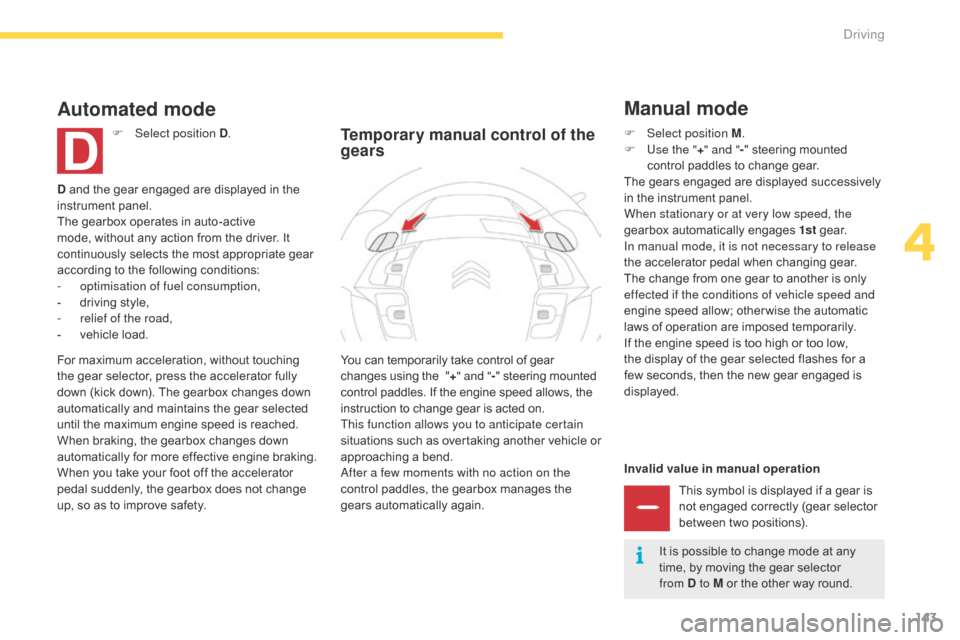
143
C4-Picasso-II_en_Chap04_conduite_ed01-2016
Invalid value in manual operationThis symbol is displayed if a gear is
n
ot engaged correctly (gear selector
b
etween two positions).
You
can
temporarily
take
control
of
gear
c
hanges
using
the
"
+" and " -"
steering
mounted
c
ontrol
paddles.
If
the
engine
speed
allows,
the
i
nstruction
to
change
gear
is
acted
on.
This function allows you to anticipate certain
situations
s
uch
a
s
ov
ertaking
a
nother
v
ehicle
o
r
a
pproaching
a
bend.
After a few moments with no action on the
control
paddles,
the
gearbox
manages
the
g
ears
automatically
again.
Temporary manual control of the
gears
Manual mode
D and the gear engaged are displayed in the in strument pan el.
The
gearbox operates in auto-active
m
ode, without any action from the driver. It
c
ontinuously selects the most appropriate gear
a
ccording to the following conditions:
-
o
ptimisation of fuel consumption,
-
d
riving style,
-
r
elief of the road,
-
v
ehicle load.
Automated mode
F Select position D .
For
maximum acceleration, without touching
t
he
gear
selector, press the accelerator fully
d
own
(kick down). The gearbox changes down
a
utomatically and maintains the gear selected
u
ntil
the
maximum engine speed is reached.
When
braking, the gearbox changes down
a
utomatically for more effective engine braking.
When
you take your foot off the accelerator
p
edal
suddenly, the gearbox does not change
u
p,
so
as
to improve safety. F
Sel ect position M.
F
U
se the "+" and " -"
steering mounted
c
ontrol paddles to change gear.
The
gears engaged are displayed successively
i
n the instrument panel.
When stationary or at very low speed, the
gearbox
automatically engages 1st
g
e a r.
In manual mode, it is not necessary to release
the
accelerator pedal when changing gear.
The
change from one gear to another is only
e
ffected if the conditions of vehicle speed and
engine
speed allow; other wise the automatic
l
aws of operation are imposed temporarily.
If
the engine speed is too high or too low,
t
he display of the gear selected flashes for a
f
ew seconds, then the new gear engaged is
d
isplayed.It
is possible to change mode at any
t
ime, by moving the gear selector
f
rom D to M or the other way round.
4
Driving
Page 147 of 527

145
C4-Picasso-II_en_Chap04_conduite_ed01-2016
Depending on the driving situation and your vehicle's equipment, the system may advise
y
ou to skip one or more gears.
You
can follow this instruction without going
t
hrough the intermediate gears..
Gear shift indicator
System which reduces fuel consumption by recommending the most suitable gear. T he system adapts its gear change
r
ecommendation according to the
d
riving conditions (gradient, load, ...)
a
nd the demands of the driver (power,
acceleration,
braking, ...).
The
system never suggests:
-
e
ngaging first gear,
-
enga
ging
r
everse
g
ear.
The information appears in the instrument
panel
in the form of an arrow.
On
vehicles with manual gearbox, the arrow
m
ay be accompanied by the recommended
g e a r.
The gear engagement recommendations
must not be considered compulsory.
This is because the configuration of the
road, traffic density and safety remain
impor tant factors in the choice of the best
g e a r.
The
gear shift indicator system does not
r
eplace the need for vigilance on the part of the
d
river.
With
an automatic gearbox, the system is only active in manual mode.
On
BlueHDi Diesel 135 and 150 versions with
m
anual gearbox, in certain driving conditions
t
he system may suggest changing into neutral
s
o that the engine can go into standby (STOP
m
ode with Stop & Start). In this case, N is
displayed
in the instrument panel.Example:
This
function cannot be deactivated.
-
Y
ou are in third gear.
-
Y
ou press the accelerator pedal.
-
T
he system may suggest that you engage
a
higher gear.
4
Driving
Page 150 of 527

148
C4-Picasso-II_en_Chap04_conduite_ed01-2016
Operating fault
Have it checked by a CITROËN dealer or a qualified w orkshop.
In the event of a fault in STOP mode, the vehicle
may
stall.
All
of the instrument panel warning lamps come on.
Depending on version, an alert message may also be displayed, asking you to place the gear
s
elector lever at position N and put your foot on
the
brake pedal.
It is then necessary to switch off the ignition and start the engine again using the "START/STOP" b
utton.
In the event of a fault with the system,
this indicator lamp flashes for a few
moments then comes on continuously,
accompanied
by a message.
Opening the bonnet
Before
doing
anything
under
the
b
onnet, deactivate the Stop & Start
system
to
avoid
the
risk
of
injury
related
t
o
an
automatic
change
to
START
m
ode.
Driving on flooded roads
Before
driving
through
a
flooded
road,
i
t
is
strongly
recommended
that
you
d
eactivate
the
Stop
&
Start
system.
For more information on Driving
advice , particularly on flooded roads,
refer
to
the
corresponding
section. The Stop & Start system requires a
battery
of advanced technology and
sp
ecial
c
haracteristics.
All
work on this type of battery must
o
nly be done by a CITROËN dealer
or
a
qualified workshop.
For more information on the
12 V
batter y ,
refer to the corresponding
s
ection.
Driving
Page 152 of 527

150
C4-Picasso-II_en_Chap04_conduite_ed01-2016
Speed limit recognition
This system allows the speed limit detected by
the camera to be displayed in the instrument
panel.
Specific speed limits, such as those for heavy
goods
vehicles, are not displayed.
The display of the speed limit in the instrument
panel
is updated as you pass a speed limit sign
i
ntended for cars (light vehicles).
The units for the speed limits (mph or
km/h)
depend on the country you are
d
riving in.
It
should be taken into account so that
y
ou observe the speed limit.
For the system to operate correctly
when
you change country, the units for
s
peed in the instrument panel must be
those
for the country you are driving in. The
automatic reading of road signs is a
d
riving assistance system and does not
a
lways display speed limits correctly.
The
speed limit signs present on the
r
oad always take priority over the
d
isplay by the system.
The system cannot in any
circumstances replace the need for
vigilance
on the part of the driver.
The
driver must observe the driving
r
egulations and must adapt the speed
o
f the vehicle to suit the weather and
traffic.
It is possible for the system to not
display the speed limit if it does not
detect
a speed limit sign within a preset
p
eriod.
The
system is designed to detect signs
t
hat conform to the Vienna Convention
on
road signs.
To maintain correct operation of the
system:
regularly clean the area in front
o
f the camera.Principles
Using a camera at the top of the windscreen, this system detects and reads speed limit and
end
of speed limit signs.
The
system also takes account of information
o
n speed limits from the navigation system
ma
pping.
Driving
Page 153 of 527
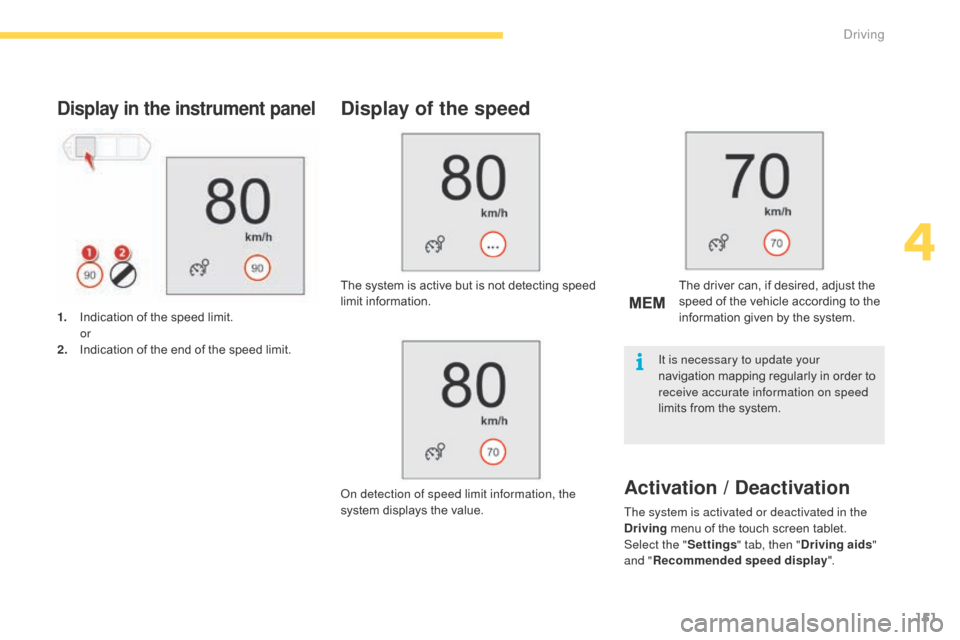
151
C4-Picasso-II_en_Chap04_conduite_ed01-2016
Display in the instrument panel
1. Indication of the speed limit.
or
2.
I
ndication of the end of the speed limit.
Display of the speed
The system is active but is not detecting speed limit in formation.
On detection of speed limit information, the
system
displays the value. The
driver can, if desired, adjust the s
peed of the vehicle according to the
i
nformation given by the system.
The system is activated or deactivated in the
Driving
menu of the touch screen tablet.
Select the " Settings" tab, then " Driving aids "
and " Recommended speed display ".
Activation / Deactivation
It is necessary to update your
navigation
mapping regularly in order to
r
eceive accurate information on speed
limits
from the system.
4
Driving
Page 154 of 527
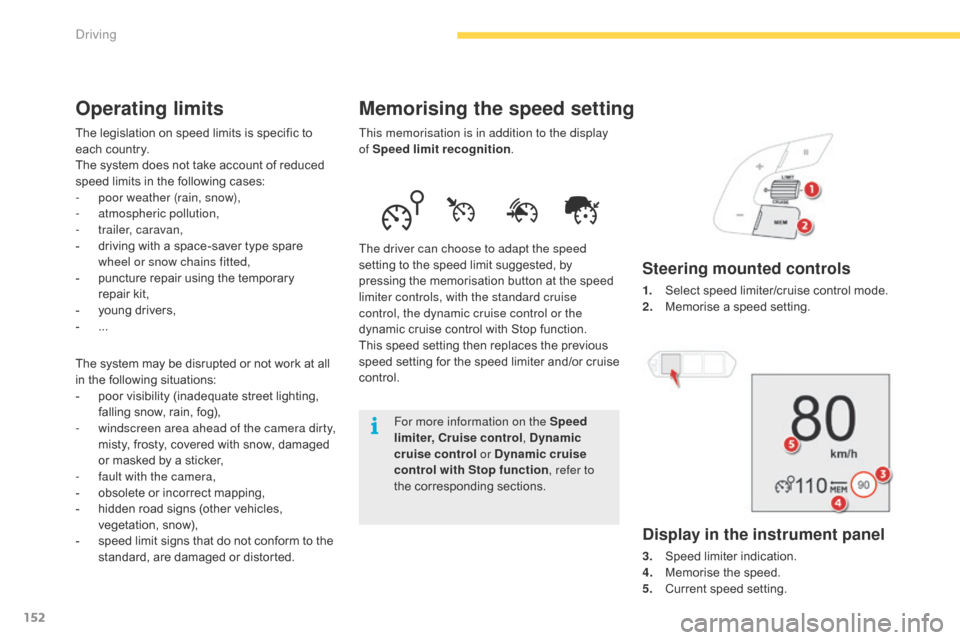
152
C4-Picasso-II_en_Chap04_conduite_ed01-2016
Memorising the speed setting
This memorisation is in addition to the display
of Speed limit recognition .
The driver can choose to adapt the speed
setting
to the speed limit suggested, by
p
ressing the memorisation button at the speed
l
imiter controls, with the standard cruise
control, the dynamic cruise control or the
dynamic
cruise control with Stop function.
This
speed setting then replaces the previous
s
peed
s
etting
f
or
t
he
s
peed
l
imiter
a
nd/or
c
ruise
c
ontrol. For more information on the Speed
limiter, Cruise control , Dynamic
cruise control or Dynamic cruise
control with Stop function , refer to
the
corresponding sections.
Steering mounted controls
1. Select speed limiter/cruise control mode.
2. M emorise a speed setting.
Operating limits
The legislation on speed limits is specific to each country.
The
system does not take account of reduced
s
peed limits in the following cases:
-
p
oor weather (rain, snow),
-
a
tmospheric pollution,
-
t
railer, caravan,
-
d
riving with a space-saver type spare
w
heel or snow chains fitted,
-
p
uncture repair using the temporary
r
epair kit,
-
y
oung
d
rivers,
-
...
T
he system may be disrupted or not work at all
i
n the following situations:
-
p
oor visibility (inadequate street lighting,
f
alling snow, rain, fog),
-
w
indscreen area ahead of the camera dirty,
misty,
frosty, covered with snow, damaged
o
r masked by a sticker,
-
f
ault with the camera,
-
o
bsolete or incorrect mapping,
-
h
idden road signs (other vehicles,
v
egetation,
s
now),
-
s
peed limit signs that do not conform to the
s
tandard, are damaged or distorted.
Display in the instrument panel
3. Speed limiter indication.
4. M emorise the speed.
5.
C
urrent speed setting.
Driving
Page 155 of 527
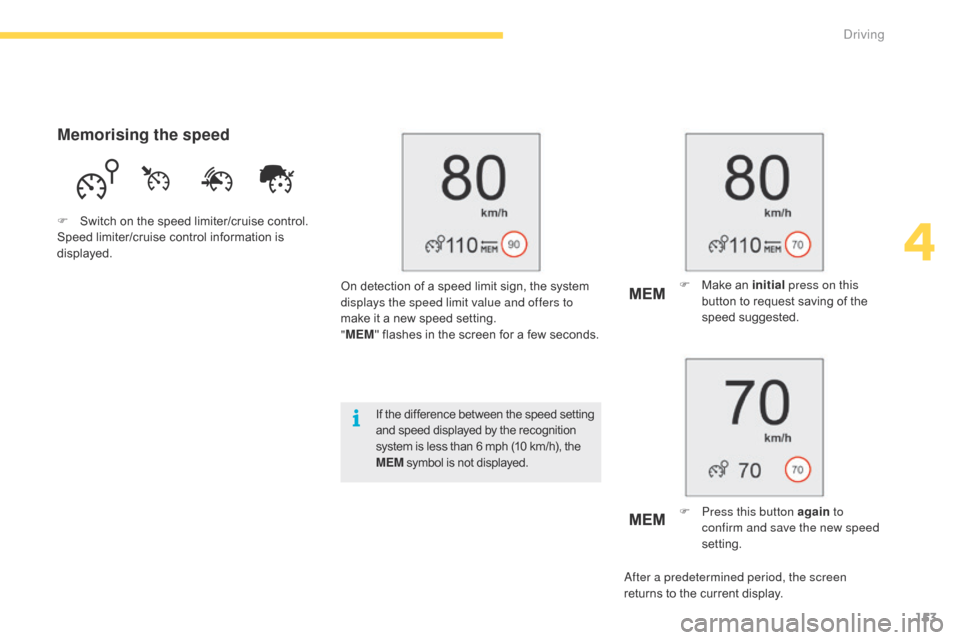
153
C4-Picasso-II_en_Chap04_conduite_ed01-2016
F Make an initial press on this
button to request saving of the
s
peed
s
uggested.
F
P
ress this button again to
confirm and save the new speed
setting.
Memorising the speed
F Switch on the speed limiter/cruise control.
Speed limiter/cruise control information is
d
isplayed.
On
detection of a speed limit sign, the system
d
isplays the speed limit value and offers to
make
it a new speed setting.
" MEM "
flashes in the screen for a few seconds.
If
the difference between the speed setting
a
nd speed displayed by the recognition
s
ystem is less than 6 mph (10 km/h), the
M
EM
symbol is not displayed.After a predetermined period, the screen
returns
to the current display.
4
Driving
Page 156 of 527
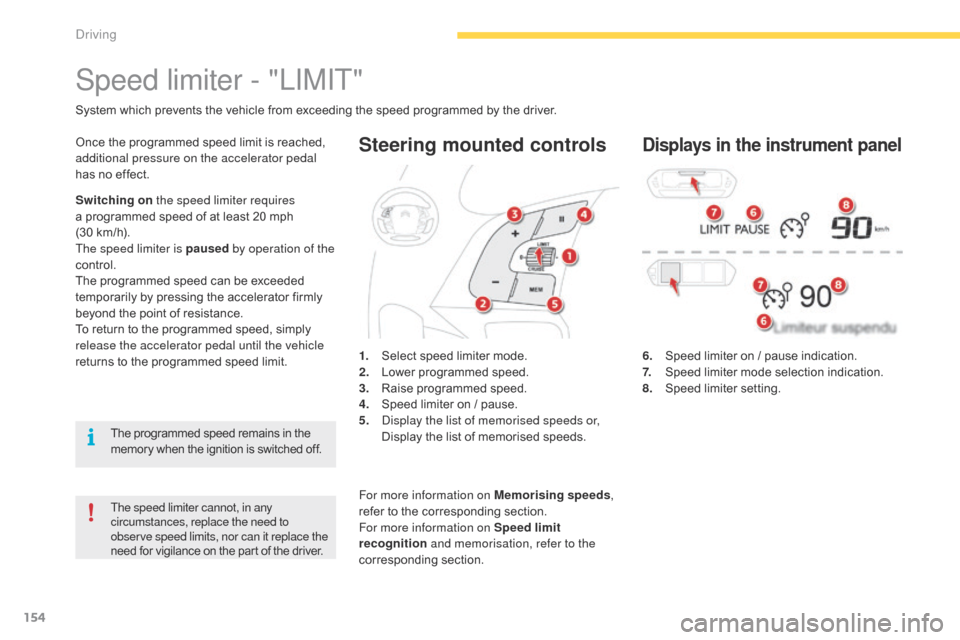
154
C4-Picasso-II_en_Chap04_conduite_ed01-2016
Steering mounted controls
6. Speed limiter on / pause indication.
7. S peed limiter mode selection indication.
8.
S
peed limiter setting.
Speed limiter - "LIMIT"
System which prevents the vehicle from exceeding the speed programmed by the driver.
The speed limiter cannot, in any
circumstances, replace the need to
observe speed limits, nor can it replace the
need
for vigilance on the part of the driver.
Once the programmed speed limit is reached, additional pressure on the accelerator pedal
has
no effect.
1.
S
elect speed limiter mode.
2.
L
ower programmed speed.
3.
R
aise programmed speed.
4.
S
peed limiter on / pause.
5.
D
isplay the list of memorised speeds or,
D
isplay the list of memorised speeds.Displays in the instrument panel
Switching on the speed limiter requires
a programmed speed of at least 20 mph
(
30 km/h).
The speed limiter is paused by operation of the
control.
The
programmed speed can be exceeded
t
emporarily by pressing the accelerator firmly
b
eyond the point of resistance.
To
return to the programmed speed, simply
r
elease the accelerator pedal until the vehicle
returns
to the programmed speed limit.
The
programmed speed remains in the
m
emory when the ignition is switched off.For more information on Memorising speeds ,
refer
to the corresponding section.
For more information on Speed limit
recognition and memorisation, refer to the
corresponding
s
ection.
Driving
Page 157 of 527
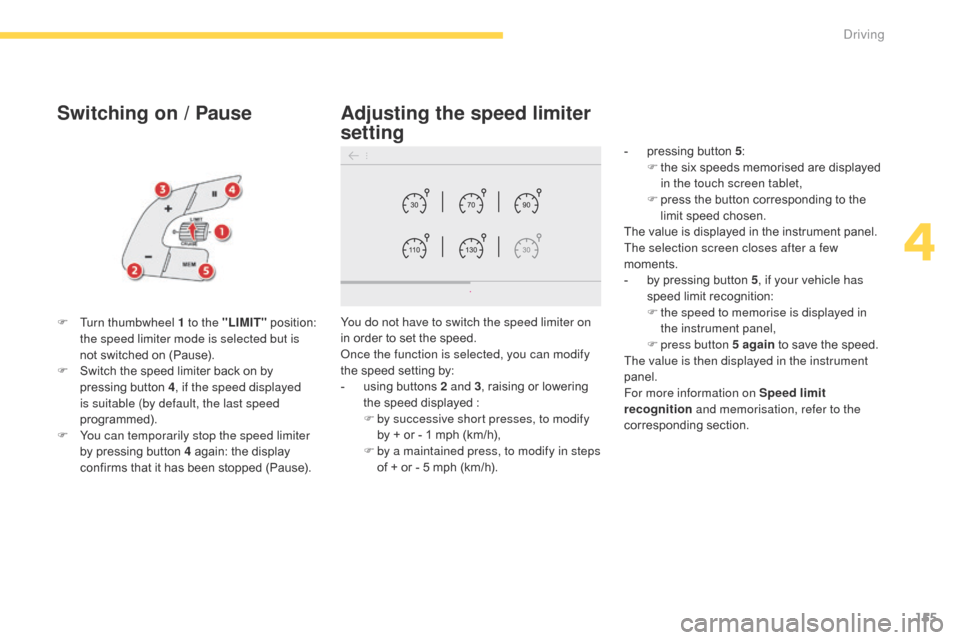
155
C4-Picasso-II_en_Chap04_conduite_ed01-2016
Switching on / Pause
F Turn thumbwheel 1 to the "LIMIT" position: t
he speed limiter mode is selected but is
not
switched on (Pause).
F
S
witch the speed limiter back on by
p
ressing button 4, if the speed displayed
is suitable (by default, the last speed
programmed).
F
Y
ou can temporarily stop the speed limiter
by
pressing button 4 again: the display
c
onfirms that it has been stopped (Pause).You do not have to switch the speed limiter on
in
order to set the speed.
Once the function is selected, you can modify
the
speed setting by:
-
u
sing buttons 2 and 3,
raising or lowering
t
he speed displayed :
F
b
y successive short presses, to modify
by
+ or - 1 mph (km/h),
F
b
y a maintained press, to modify in steps
of
+ or - 5 mph (km/h).
Adjusting the speed limiter
setting
- pressing button 5:
F t he six speeds memorised are displayed
i
n the touch screen tablet,
F
p
ress the button corresponding to the
l
imit speed chosen.
The
value is displayed in the instrument panel.
The selection screen closes after a few
moments.
-
b
y pressing button 5, if your vehicle has
speed
limit recognition:
F
t
he speed to memorise is displayed in
the instrument panel,
F
press button 5 again
to save the speed.
The value is then displayed in the instrument
panel.
For more information on Speed limit
recognition and memorisation, refer to the
corresponding
s
ection.
4
Driving
Page 158 of 527
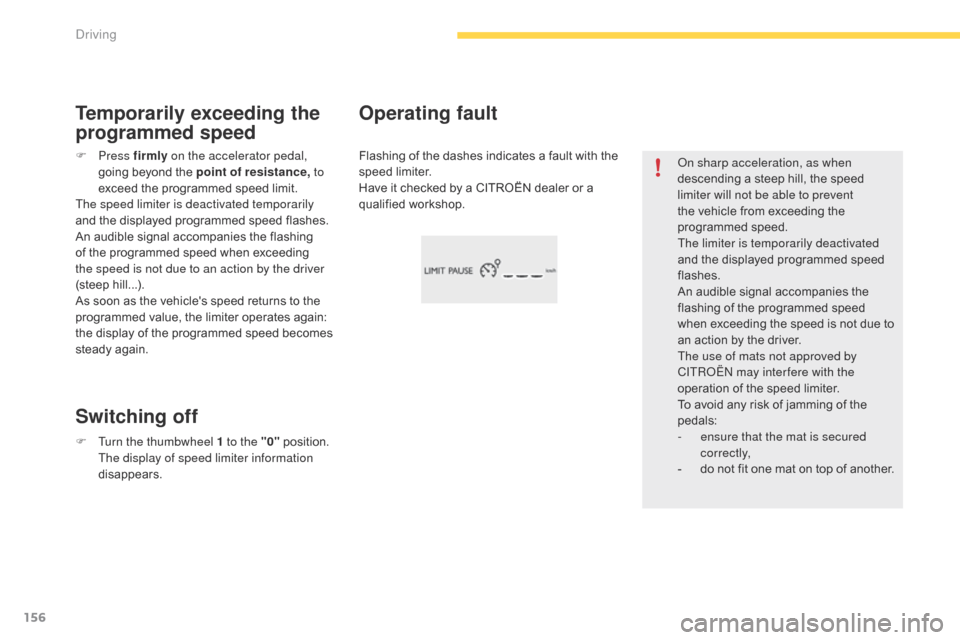
156
C4-Picasso-II_en_Chap04_conduite_ed01-2016
On sharp acceleration, as when
descending a steep hill, the speed
l
imiter will not be able to prevent
the
vehicle from exceeding the
pro
grammed
s
peed.
The limiter is temporarily deactivated
and
the displayed programmed speed
f
lashes.
An
audible signal accompanies the
f
lashing of the programmed speed
w
hen exceeding the speed is not due to
a
n action by the driver.
The use of mats not approved by
CITROËN may inter fere with the
operation
of the speed limiter.
To
avoid any risk of jamming of the
ped
als:
-
e
nsure that the mat is secured
c o r r e c t l y,
-
d
o not fit one mat on top of another.
Flashing
of
the
dashes
indicates
a
fault
with
the
sp
eed l
imiter.
Have
it
checked
by
a
CITROËN
dealer
or
a
q
ualified
w
orkshop.
Operating fault
F Press f irmly on the accelerator pedal,
going beyond the point of resistance, to
exceed
the programmed speed limit.
The speed limiter is deactivated temporarily
and
the displayed programmed speed flashes.
An
audible signal accompanies the flashing
o
f the programmed speed when exceeding
t
he speed is not due to an action by the driver
(steep
h
ill...).
As
soon as the vehicle's speed returns to the
p
rogrammed value, the limiter operates again:
t
he display of the programmed speed becomes
s
teady again.
Switching off Temporarily exceeding the
programmed speed
F Turn the thumbwheel 1 to the "0" p osition. T
he display of speed limiter information
disappears.
Driving